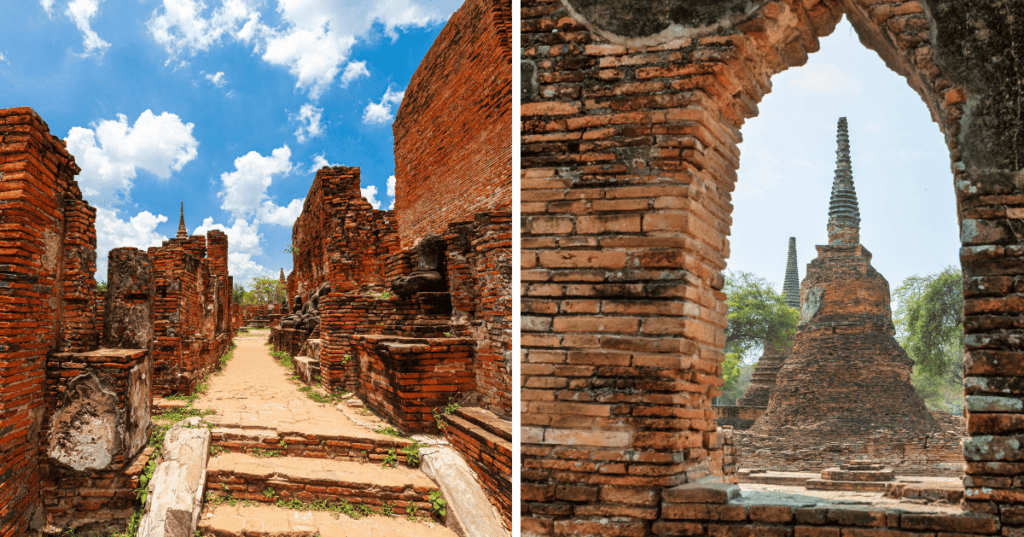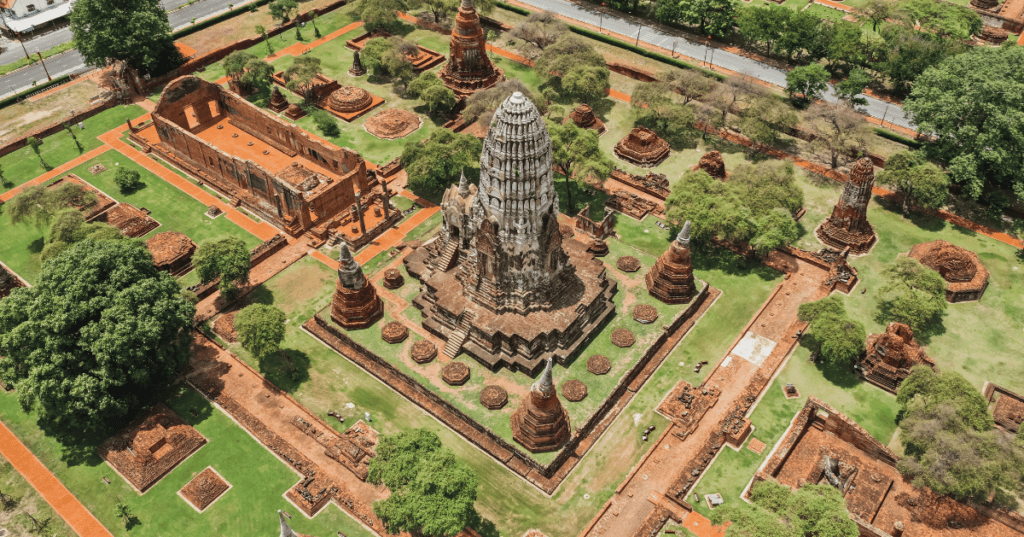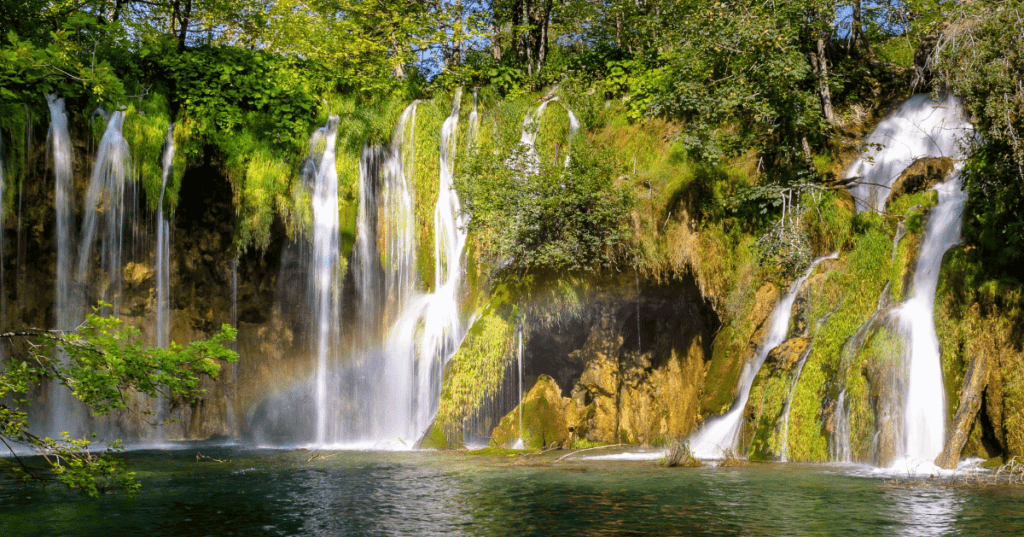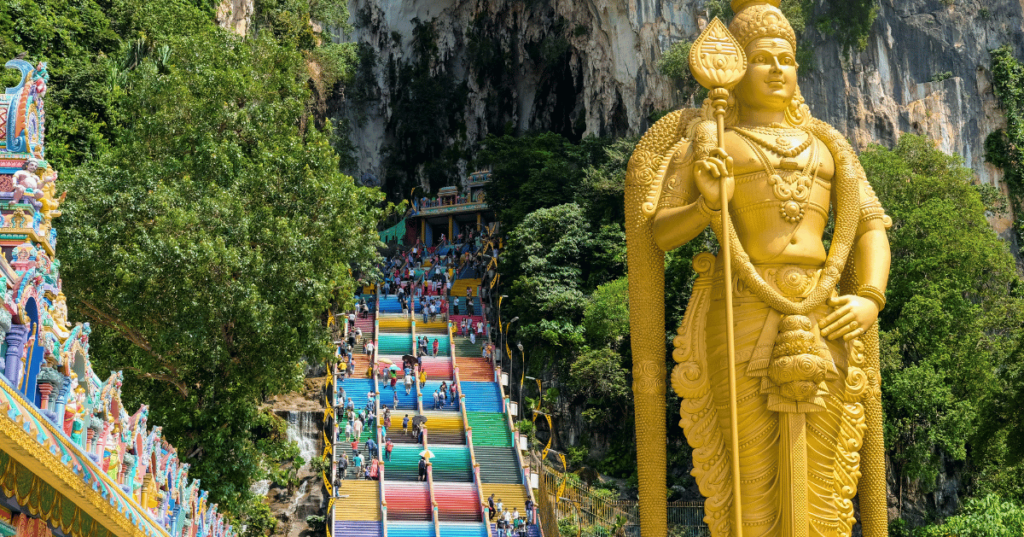Introduction Temples and Ruins of Ayutthaya
Ayutthaya, located about 80 km north of Bangkok, is one of Thailand’s most important historical sites. Once the capital of the Siamese kingdom, the city is now a UNESCO World Heritage Site, famous for its temple ruins and historical landmarks.
Covering a large area, Ayutthaya’s ruins include grand temples, Buddha statues, and remnants of royal palaces. Visitors can explore iconic spots like Wat Mahathat, known for the Buddha head entwined in tree roots, and Wat Phra Si Sanphet, which was once the grandest temple in the ancient capital.
To help you explore Thailand’s rich cultural heritage, this guide highlights the must-see temples and ruins of Ayutthaya. You’ll also find helpful tips for touring this ancient city. Explore the wealth of Ayutthaya and discover what lies ahead!
Related Post : Sukhothai: A Journey Through Thailand’s First Kingdom
A Brief History of Ayutthaya
Founded in 1350, Ayutthaya served as the second capital of the Kingdom of Siam for over 400 years. It became one of the most important cities in Southeast Asia, known for its powerful trade connections and rich culture. At its peak, Ayutthaya was home to over a million people, making it one of the largest cities in the world at the time.
The city was strategically located on an island surrounded by three rivers, which provided both natural defense and easy access for trade. During its golden age, Ayutthaya attracted merchants from all over the world, including China, India, Japan, and even Europe.
However, in 1767, Ayutthaya was invaded and destroyed by the Burmese army, leaving the once-thriving city in ruins. Despite the destruction, many of the temples and structures have been preserved or restored, offering visitors a chance to explore the remains of Thailand’s glorious past.
Today, Ayutthaya is a UNESCO World Heritage Site and a major tourist destination, drawing visitors from around the world to its historical ruins and temples.
Top Temples and Ruins to Visit in Ayutthaya

Ayutthaya is home to numerous temple ruins, each offering a unique glimpse into Thailand’s past. Here are some of the most iconic sites you should explore during your visit:
Wat Mahathat
One of the most famous temples in Ayutthaya, Wat Mahathat is best known for the iconic Buddha head entwined in the roots of a banyan tree. Built in the 14th century, this temple once served as the center of religious and political activity in the kingdom. Despite much of it being in ruins today, it remains one of the must-see spots in Ayutthaya.
Wat Phra Si Sanphet
As the largest temple in Ayutthaya, Wat Phra Si Sanphet was originally part of the royal palace grounds. It once housed a 16-meter-tall golden Buddha statue that was destroyed during the Burmese invasion. The three large chedis (stupas) that dominate the site are its most recognizable feature, making it a significant landmark in the city.
Wat Ratchaburana
Located near Wat Mahathat, Wat Ratchaburana is known for its impressive central prang (tower) and the intricate murals inside its crypt. The temple was built in memory of two princes who died in battle. Though some of the structures have collapsed, Wat Ratchaburana still offers stunning architecture and historical value.
Wat Chaiwatthanaram
Situated along the banks of the Chao Phraya River, Wat Chaiwatthanaram is one of the best-preserved temples in Ayutthaya.
Built in 1630, it was modeled after Angkor Wat and reflects the influence of Khmer architecture. Its striking symmetry and beautiful riverside setting make it a popular spot for both tourists and photographers.
How to Explore Ayutthaya’s Temples
Ayutthaya’s temples and ruins are spread across the city, but navigating them is relatively easy with a few options available for visitors:
By Bicycle
One of the most popular ways to explore Ayutthaya is by renting a bicycle. Many of the main temples are close enough to each other, making it a great option for those who enjoy a more active and leisurely pace. There are several rental shops around the city, and the cost is quite affordable, usually around 50-100 THB per day.
By Tuk-Tuk
If cycling isn’t your thing, tuk-tuks are readily available for hire. These colorful three-wheeled taxis offer a convenient way to get around the city, especially if you want to cover more ground in less time. Negotiate a price with the driver for a full-day tour, which typically ranges from 300-500 THB depending on how many sites you plan to visit.
By Boat
For a different perspective, consider taking a boat tour around the city’s rivers. Many tour operators offer half-day or full-day river cruises that stop at various temples located along the water. This allows you to experience Ayutthaya’s historical sites while enjoying a relaxing trip on the Chao Phraya River.
On Foot
If you prefer a more relaxed pace, you can explore parts of Ayutthaya on foot. Some of the temples are within walking distance of each other, especially in the central area. However, keep in mind that Ayutthaya’s tropical heat can be intense, so it’s important to bring water, wear sunscreen, and plan your route carefully.
Best Time to Visit Ayutthaya
Ayutthaya can be visited year-round, but certain times of the year offer a more comfortable experience depending on the weather and local events.
Cool Season (November to February)
The cool season is the most popular time to visit Ayutthaya. During these months, temperatures range from 20°C to 30°C (68°F to 86°F), making it ideal for walking or cycling around the ruins. This period also sees less rain, which means you’ll have clear skies for exploring the temples. It’s the peak tourist season, so you may encounter larger crowds, especially during weekends and public holidays.
Hot Season (March to May)
If you don’t mind the heat, the hot season can still be a good time to visit, although temperatures often rise above 35°C (95°F). It’s less crowded during these months, so you can explore at a more relaxed pace. Just be sure to stay hydrated, wear a hat, and apply plenty of sunscreen. Visiting early in the morning or later in the afternoon when the sun is less intense is recommended.
Rainy Season (June to October)
While the rainy season brings unpredictable weather, it can also be a quieter time to explore Ayutthaya. Showers are usually brief but heavy, and the landscape becomes lush and green. If you don’t mind a bit of rain, you’ll find fewer tourists and lower accommodation prices. Just be prepared with a raincoat or umbrella, and check the weather forecast before heading out.
Tips for Visiting Ayutthaya’s Temples
Exploring Ayutthaya’s temples is a rewarding experience, but it’s good to keep a few tips in mind to make your visit smooth and enjoyable.
Dress Modestly: Many of Ayutthaya’s temples are still considered sacred places, so it’s important to dress respectfully. Visitors should cover their shoulders and knees when entering the temple grounds. If you’re cycling or walking between sites, it’s a good idea to carry a light scarf or shawl to quickly cover up when needed.
Stay Hydrated: Ayutthaya can get hot, especially during the afternoon. Make sure to carry a bottle of water with you as you explore the ruins. There are also small shops and vendors around the main temple sites where you can buy drinks or snacks.
Wear Comfortable Shoes: The temples in Ayutthaya are spread out across a large area, and you’ll likely be walking or cycling between them. Wear comfortable shoes that you don’t mind getting a little dusty, as some paths can be uneven or sandy.
Start Early: If you want to avoid the crowds and the midday heat, try to start your day early. Many of the temples open around 8:00 AM, so getting there first thing in the morning allows you to explore at a slower pace without too many other visitors.
Bring a Camera: Ayutthaya’s ancient ruins are incredibly photogenic. From the iconic Buddha head at Wat Mahathat to the towering stupas of Wat Phra Si Sanphet, there are plenty of picture-perfect moments waiting to be captured. Just be mindful of temple etiquette—avoid taking photos during religious ceremonies or of people in prayer.
How to Get to Ayutthaya
Ayutthaya is located just north of Bangkok, making it a popular day-trip destination for both locals and tourists. Here are the best ways to get there:
By Train
One of the most scenic and budget-friendly ways to reach Ayutthaya is by train. Trains depart regularly from Bangkok’s Hua Lamphong Station, and the journey takes about 1.5 to 2 hours. The second-class and third-class seats are very affordable, with prices starting as low as 15-20 THB. The train station in Ayutthaya is located close to the main historical park, and you can easily find tuk-tuks or bicycle rentals to begin exploring the temples.
By Bus or Minivan
Buses and minivans run frequently from Bangkok’s Mo Chit Bus Terminal to Ayutthaya, and the trip takes around 1.5 hours. Minivans are slightly faster and cost around 60-100 THB. They’re also a good option if you’re staying in central Bangkok, as there are several departure points in the city.
By Car
For more flexibility, renting a car can be a convenient option. The drive from Bangkok to Ayutthaya takes about 1-1.5 hours depending on traffic. It’s an easy route, mainly following the AH1 highway. Parking is available near most temple sites, but be mindful of local driving rules and conditions.
By Boat
If you’re looking for a more unique experience, some companies offer boat tours from Bangkok to Ayutthaya along the Chao Phraya River. These trips typically take longer—around 3-4 hours—but offer a scenic and relaxing journey. It’s a slower-paced option that’s perfect if you have time and want to enjoy the river views.
Final Thoughts on Ayutthaya’s Temples
Visiting Ayutthaya is like stepping back in time. The ancient temples and ruins tell stories of a glorious past, showcasing the incredible architectural and cultural heritage of Thailand. Whether you’re wandering through the remains of Wat Phra Si Sanphet or capturing the serene beauty of the Buddha head entwined in tree roots at Wat Mahathat, each site offers a unique glimpse into the history of this once-thriving city.
Ayutthaya is not just a day trip from Bangkok; it’s an opportunity to immerse yourself in Thailand’s rich history. Take your time exploring the temples, savoring local food, and enjoying the peaceful atmosphere. And don’t forget to bring your camera—the stunning architecture and landscapes are sure to leave you with lasting memories.
As you plan your visit, keep in mind the tips we discussed to enhance your experience. Remember, the journey is just as important as the destination. So, whether you choose to bike, boat, or tuk-tuk your way around, enjoy every moment of your adventure in this historical gem.
Frequently Asked Questions About Ayutthaya’s Temples
1. How long should I spend in Ayutthaya?
Most visitors find that a day is sufficient to see the main temples and ruins. However, if you want to explore at a leisurely pace or visit lesser-known sites, consider spending a night in Ayutthaya. This allows you to enjoy the sunset and early morning views of the temples without the crowds.
2. Are the temples in Ayutthaya free to enter?
Many temples in Ayutthaya have free entry, but some charge a small fee (usually around 20-50 THB) for maintenance and preservation. It’s best to have cash on hand, as not all sites accept credit cards.
3. Can I bring food and drinks into the temple grounds?
While you can bring water into most temple areas, it’s best to avoid bringing large meals or snacks. Eating is typically not allowed within the temple grounds, but there are plenty of local eateries nearby where you can enjoy a meal.
4. Is it safe to visit Ayutthaya?
Ayutthaya is generally safe for tourists. As with any travel destination, it’s wise to stay aware of your surroundings and keep an eye on your belongings, especially in crowded areas.
5. What should I do if I can’t speak Thai?
English is commonly spoken in tourist areas, and many signs are in both Thai and English. Basic phrases can help, but you’ll find that most locals are friendly and willing to assist even if there’s a language barrier.
6. Are there guided tours available?
Yes, many companies offer guided tours of Ayutthaya. These can be a great way to learn more about the history and significance of each temple. You can choose from group tours or private guides, depending on your preference.







